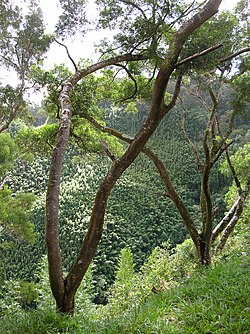Acacia confusa
Species of plant From Wikipedia, the free encyclopedia
Acacia confusa is a perennial tree native to South-East Asia. Some common names for it are ayangile, small Philippine acacia, Formosa acacia (Taiwan acacia), Philippine Wattle, and Formosan koa. It grows to a height of 15 m. The tree has become very common in many tropical Pacific areas, including Hawaii, where the species is considered invasive.[3]
| Acacia confusa | |
|---|---|
 | |
| Scientific classification | |
| Kingdom: | Plantae |
| Clade: | Tracheophytes |
| Clade: | Angiosperms |
| Clade: | Eudicots |
| Clade: | Rosids |
| Order: | Fabales |
| Family: | Fabaceae |
| Subfamily: | Caesalpinioideae |
| Clade: | Mimosoid clade |
| Genus: | Acacia |
| Species: | A. confusa |
| Binomial name | |
| Acacia confusa | |
 | |
| Range of Acacia confusa | |
| Synonyms | |
Uses
The wood has a density of about 0.75 g/cm3.[4] In Taiwan, its wood was used to make support beams for underground mines.[citation needed] Acacia confusa is challenging to work and for this reason was traditionally burned as firewood or turned into charcoal in Taiwan. In later years it was exported to China to be made into wood flooring for the American market. At its height Taiwan exported more than 1,000 containers of Taiwan acacia to China. More recently it has been used domestically to produce high value wood products like musical instruments, furniture, and bathtubs.[5]
The wood is also converted to charcoal for family use. The plant is used in traditional medicine[6] and is available from herbal medicine shops in Taiwan, but there has been no clinical study to support its effectiveness.[citation needed]
Phytochemicals
Phytochemicals found in Acacia confusa:
Root bark
Seeds
- Oxalyldiaminopropionic acid (α-amino-β-oxalylaminopropionic acid),[8] which can cause neurological damage, paralysis, and death.
Stems
- N-Methyltryptamine, 0.04%[7]
Varieties
- Acacia confusa var. inamurai Hayata
See also
References
External links
Wikiwand - on
Seamless Wikipedia browsing. On steroids.




